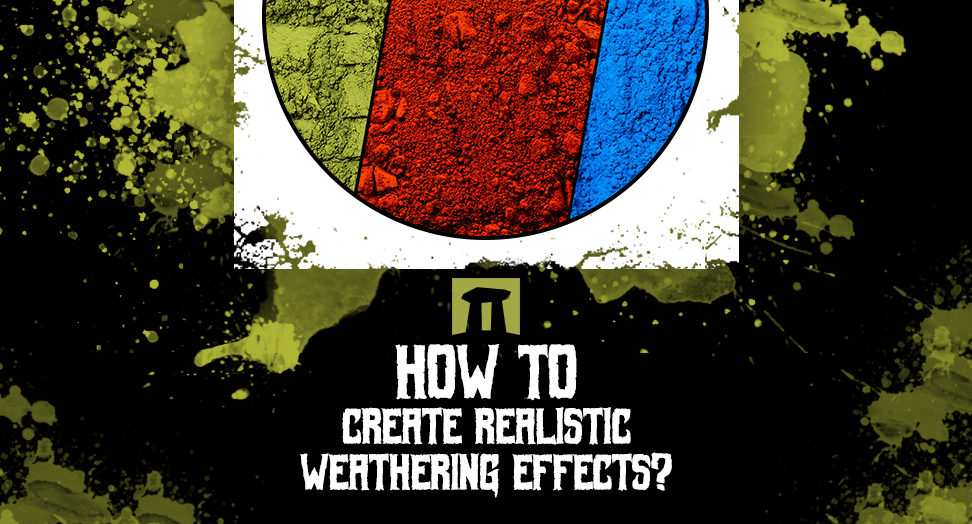How to create realistic weathering effects?

Creating a realistic weathering effect requires a higher level of painting skills than those usually possessed by the beginners. How to make paint look weathered on metal is a question you ask yourself after you already have painted - at least - several miniatures. Luckily, nowadays - besides traditional tips and techniques for weathering models - we may also reach for some pre-prepared tools that help achieve such effects with ease. What’s even more convenient, we have some of them here, at Kromlech!
Guide to realistic weathering effects: techniques and tips
There is no one way of how to weather a model. That’s because in real life, in nature, there are some different examples of aging - metal ages in a distinct way from other materials, and it might look differently because of the environment it was left in. If we want to achieve such an effect - and we wish it to look as realistic as possible - we need to utilize various weathered paint techniques.
“Drybrushing” or adding a small portion of water to your paints might help you achieve weathering effects. The second solution may be implemented even simpler, thanks to the paints regarded as "shades". These are highly-watered colors that will provide you with results comparable to when you put some oil paint on the surface of models you wish to weather.
Nonetheless, the effects achieved thanks to the examples listed above might come out as not satisfying enough. These are probably the easiest ways of weathering models, but that easiness has its price. If you crave for more impressive results, you need to seek further.
Weathering your projects: how to create realistic effects on models and crafts
The work is much more straightforward when you possess suitable tools. And such tools are weathering powders. These materials - which come in various colors - are perfect to use during the step of adding finishing touches to your miniature. Although the process of putting them on your models may require some practice, the advantages it brings with itself are undeniable.

Dirty Down Paints are perfect for creating certain weathering effects
It’s good to underline that not only miniatures may benefit from that solution. Weathering powders aren’t only for small models. They’ll do the job when used to weather even bigger surfaces such as the ones of vehicles - like tanks and planes - and whole buildings - both ruins, or Imperium-style chapels and cathedrals.
Advanced weathering techniques: creating texture, rust, and more
If your intent is to create a texture on your models, you should give a closer look at Dirty Down Paints. These water soluble specifics were used to make costumes and scenography on the movies’ sets look more realistic, and now they can do the same for your miniatures. Rust effect paint, moss effect paint, and verdigris effect paint cover almost all effects you can think of when giving your models a more realistic look.
Weathering paint is both a practical and a good-looking solution. Although the effect it provides might not be visible instantly after applying it on the surface, worry not - all you have to do is to give it two or three minutes. We can assure you that you’ll see the difference between before and after that time.
Creative ways to use weathering techniques for unique model and craft projects
All the ways and tools for adding weathering to models that we stated above have their advantages and disadvantages. Some of them have more first ones, and some of them - second ones. After all, it’s up to you and your preferences, which solution you pick. Remember, that there are some distinct ways of using each and every one of those techniques. Weathering is just one word, but it has many various appearances.
There is no doubt (at least in our minds) that weathering effects on models are something that improves their look. It’s vital when you wish your models to be as realistic as possible. Nonetheless - as with everything - you need to watch out to not overdo it. Of course, it all depends. It’s completely understandable, that when you want to make extremely aged metal doors, totally covered with rust, you’ll need to use the tools we're talking about in noticeable quantities. Still, there are some instances when weathering effects don’t need to be used. At least, not in significant proportions.
What’s more, depending on what kind of model you’re working on, some effects might be more needed to appear, while others - not necessarily. When weathering ship models, moss effect will surely do the majority of work. Of course, only when we’re talking about a ship that sails across the oceans. If it’ll be a spaceship - abandoned on the intergalactic junkyard - then rust is something that will cover a vital amount of its surface.




